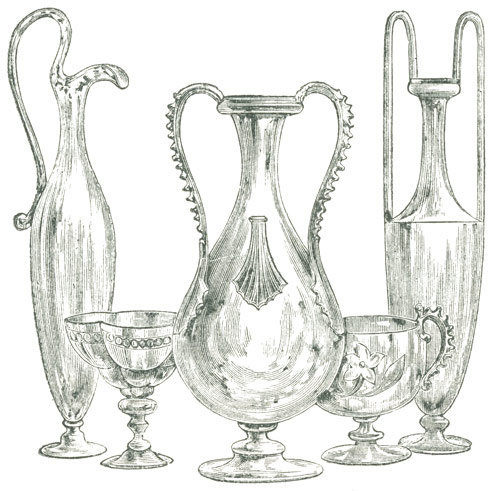A heavy cross of ruby glass, branches in bronze, with, ruby oil-cups.
Lamps in the Arabian style.
A cup with two handles, on a foot of white glass, the whole surrounded on the outside with a reticular net work of the same glass in the form of entwined ribbons, completely detached from the body of the cup, but united to it at foot and top.
Of the mosaic work I cannot undertake to give a description, but its excellence cannot be too highly praised. The articles made by this house are in ordinary white glass — no flint is used. They employ about 210 workmen, including 65 children. The work, as may be imagined, is all done by hand, and the glass is baked in muffle furnaces. The articles are principally reproductions of ancient Greek, Roman, and Egyptian antique glasses in many colors, carved out of blocks; articles imitating Christian glass, with gilding between two layers of glass and mosaics in colored glass, of which they claim to have more than 9,000 shades. The finest work of this firm is the filigree, which seems to be faultless.
Salviati & Co., Venice. This house exhibits a great many articles in the same style as the Venice and Murano Company.
Quite a variety of jugs, pots, vases, of marbleized, mottled, and metalized glass.
Articles of different colored filigree.
Ruby-colored vases of a very handsome purplish ruby, with opal threads and border.
The filigree work of this house is finely done and the prices very low.
A flat bowl, 17 inches, of mottled spirals of different colors.
Another bowl, 28 inches, in mottled pink, yellow, and blue, the stem in bluish aventurine, the border in waved scalloped border, in imitation of a shell.
A set of blue bowls in very pretty color, painted in gold enamel.
A vase, 24 inches high, in white glass, with blue and opal waves; badly blown, but pretty in colors.
A pair of vases, blue outside with opal inside; a very pretty color combination.
Vases in gold, mottled, with white-glass handles made of two swans with red bills; the handles poorly executed, the vase pretty.
A variety of mirrors with silvered and engraved glass frames, with top pieces of the same.
In this house, as in the preceding, I saw several samples of beautiful ruby; in fact, such ruby as could not be seen elsewhere.
A vase of green glass, with gold flakes.
Goblets gilded in the bowl up to a certain height, and spiral ruby filigree with opalescent horizontal threads; a handsome combination.
The same gilding as in the preceding house could also be seen in a variety of articles, the designs being shown by denuded outlines.




